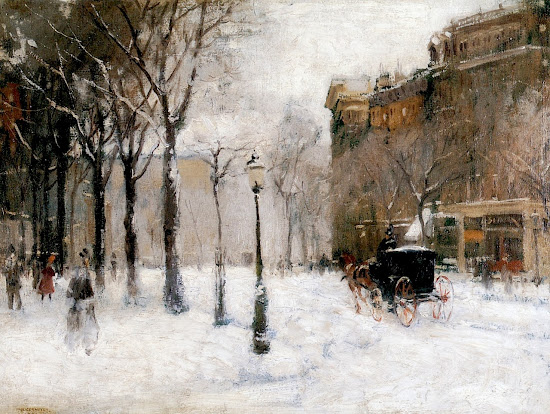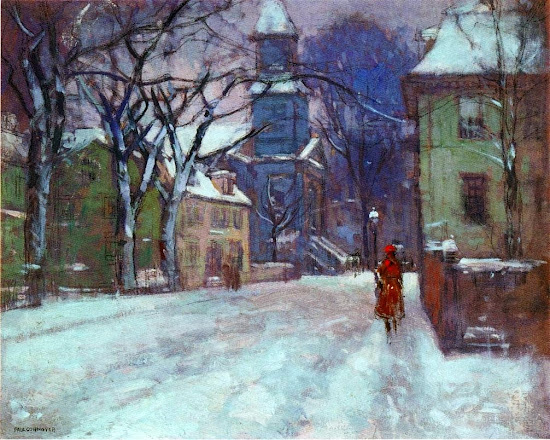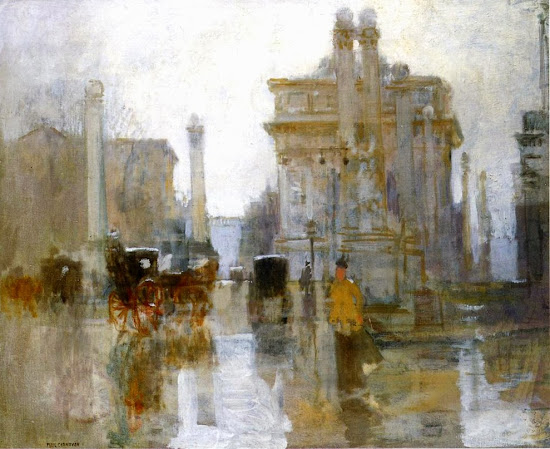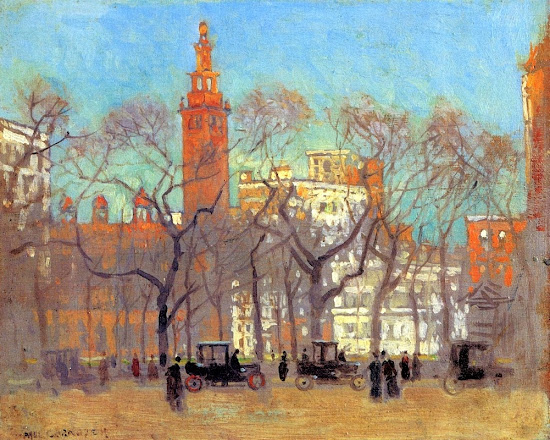Biography:
Paul Cornoyer, the noted painter of New York City street scenes, was born in St. Louis, Missouri, in 1864. He developed an interest in art during his boyhood. At the age of seventeen he initiated his formal education at the St. Louis School of Art, where he received much encouragement from the school's director, Halsey C. Ives. During this period, he supported himself by working as a reporter for the St. Louis Republic. By 1889 he had saved enough money to travel to Paris for additional study. He enrolled in classes at the Academié Julian, working under such eminent teachers as Jules Lefebvre, Louis Blanc and Benjamin Constant. In addition to his academic training, he became profoundly influenced by the work of the French Impressionists. He also began to exhibit his work in Paris. One of his paintings was featured in the Salon of 1892 and in the same year, he was awarded a first prize medal from the American Art Association of Paris. While living abroad, Cornoyer visited many of the famous cities of Europe, such as London and Venice. He subsequently developed an affinity and a fascination with urban street life. This would soon become his favorite subject matter, painted under all types of weather conditions.../
Paul Cornoyer, the noted painter of New York City street scenes, was born in St. Louis, Missouri, in 1864. He developed an interest in art during his boyhood. At the age of seventeen he initiated his formal education at the St. Louis School of Art, where he received much encouragement from the school's director, Halsey C. Ives. During this period, he supported himself by working as a reporter for the St. Louis Republic. By 1889 he had saved enough money to travel to Paris for additional study. He enrolled in classes at the Academié Julian, working under such eminent teachers as Jules Lefebvre, Louis Blanc and Benjamin Constant. In addition to his academic training, he became profoundly influenced by the work of the French Impressionists. He also began to exhibit his work in Paris. One of his paintings was featured in the Salon of 1892 and in the same year, he was awarded a first prize medal from the American Art Association of Paris. While living abroad, Cornoyer visited many of the famous cities of Europe, such as London and Venice. He subsequently developed an affinity and a fascination with urban street life. This would soon become his favorite subject matter, painted under all types of weather conditions.../
.../Cornoyer returned to St. Louis in 1894. Not long after his arrival he was awarded a gold medal from the St. Louis Association of Painters and Sculptors. He was also commissioned to paint a mural for the staircase of the Planter's Hotel. Yet despite his apparent success, Cornoyer found it difficult to support himself as an artist in his native city. By chance, however, one of his pictures, on display at the Pennsylvania Academy of the Fine Arts in Philadelphia, caught the eye of the eminent painter William Merritt Chase, who promptly purchased it for his own collection. He subsequently advised the young Cornoyer to come to New York. Following the master's advice, Cornoyer arrived in Manhattan in 1898. Through his association with Chase, he was introduced to other Impressionist-inspired artists, including Childe Hassam and John Henry Twachtman. He soon began to devote the majority of his time to the portrayal of the city's parks, streets and squares, depicted in sunlight, moonlight, rain and snow, often intermingling natural and artificial light. Drawing on the tradition of such French Impressionists as Edgar Degas and Gustave Caillebotte, he quickly developed a reputation as one of the most significant interpreters of the American urban scene.
As Cornoyer's renown continued to grow, he became a frequent recipient of awards and prizes. A member of the prestigious Salmagundi Club, he was awarded the Evans Prize (1905), the Inness Prize (1906) and the Shaw Purchase Prize (1908). He was elected an Associate member of the National Academy of Design in 1909. A popular teacher, he attracted many students to his summer classes at Gloucester, Massachusetts. He moved permanently to East Gloucester in 1917.
Cornoyer continued to paint and exhibit his work right up until his death in 1923. Representative examples of his oeuvre can be found in prominent collections throughout the United States, including the Brooklyn Museum, the St. Louis Art Museum and the Dallas Art Association.../
As Cornoyer's renown continued to grow, he became a frequent recipient of awards and prizes. A member of the prestigious Salmagundi Club, he was awarded the Evans Prize (1905), the Inness Prize (1906) and the Shaw Purchase Prize (1908). He was elected an Associate member of the National Academy of Design in 1909. A popular teacher, he attracted many students to his summer classes at Gloucester, Massachusetts. He moved permanently to East Gloucester in 1917.
Cornoyer continued to paint and exhibit his work right up until his death in 1923. Representative examples of his oeuvre can be found in prominent collections throughout the United States, including the Brooklyn Museum, the St. Louis Art Museum and the Dallas Art Association.../









No hay comentarios.:
Publicar un comentario